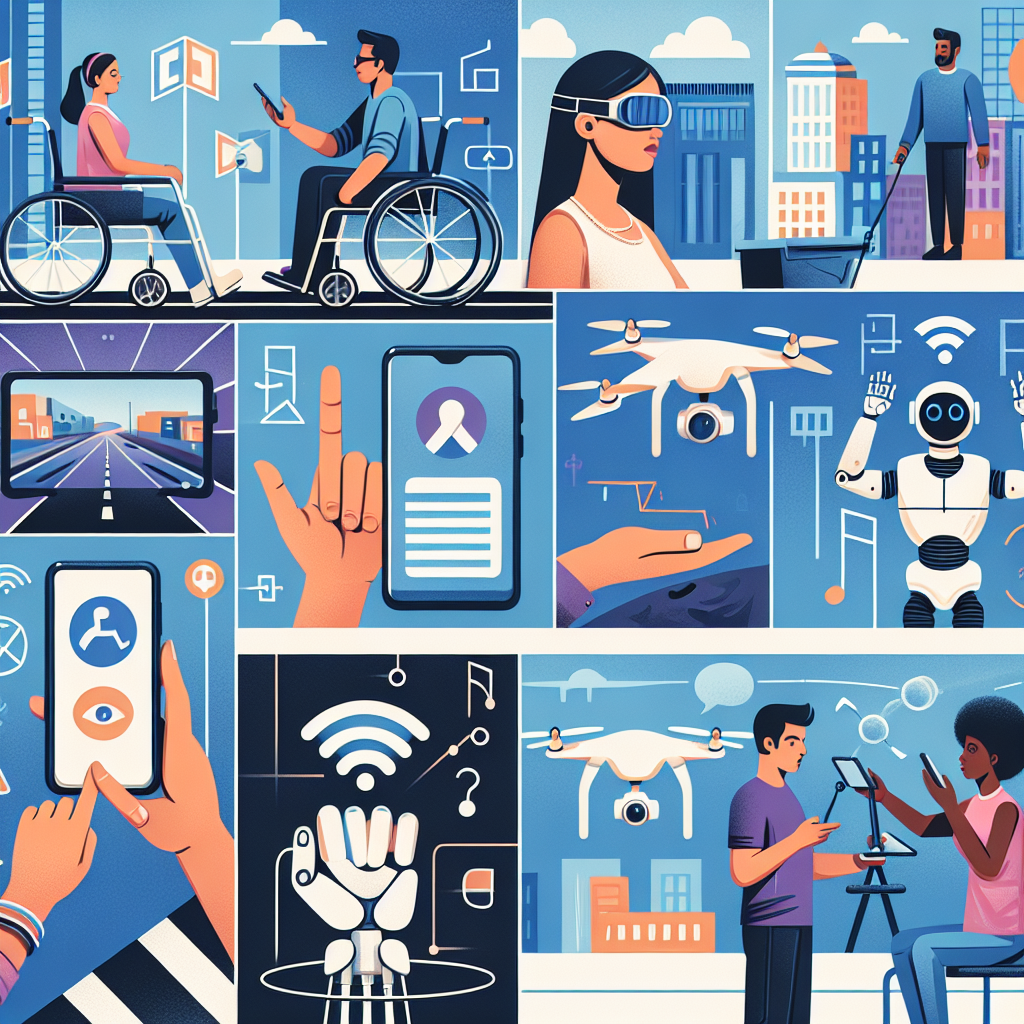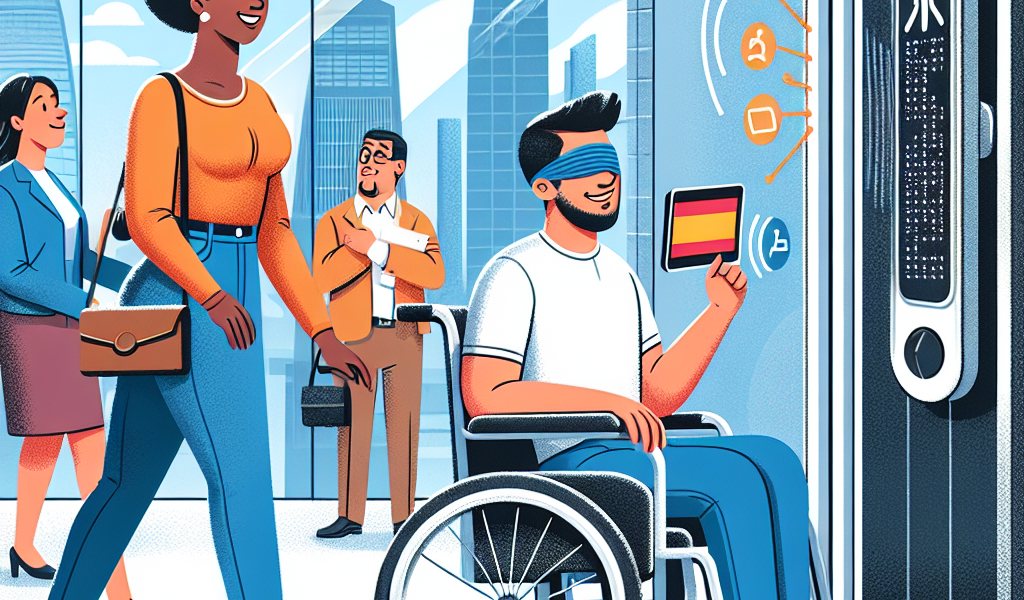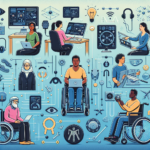-
Table of Contents
“Empowering Inclusion: Technology Bridging Accessibility Gaps”
Introduction

The Role of Technology in Enhancing Accessibility
In an increasingly digital world, technology plays a pivotal role in bridging gaps and fostering inclusivity. The advent of innovative tools and solutions has significantly enhanced accessibility for individuals with disabilities, ensuring they can participate fully in various aspects of life. From screen readers and voice recognition software to advanced prosthetics and smart home devices, technology has transformed the way people with disabilities interact with their environment. This progress not only empowers individuals by providing greater independence and opportunities but also promotes a more inclusive society where everyone can contribute and thrive. As technology continues to evolve, its potential to further enhance accessibility and improve quality of life for all remains boundless.
Innovations in Assistive Technology for People with Disabilities
In recent years, the role of technology in enhancing accessibility has become increasingly significant, particularly for people with disabilities. Innovations in assistive technology are transforming lives, breaking down barriers, and fostering greater inclusion in various aspects of daily living. From communication tools to mobility aids, these advancements are not only improving the quality of life for individuals with disabilities but also promoting a more inclusive society.
One of the most notable areas of progress is in communication technology. For individuals with speech impairments, devices such as speech-generating devices (SGDs) have been revolutionary. These tools allow users to convert text into spoken words, enabling them to communicate more effectively with those around them. Additionally, advancements in software applications, such as voice recognition and text-to-speech programs, have made it easier for people with visual or motor impairments to interact with digital devices. These technologies are not only enhancing personal communication but also opening up new opportunities in education and employment.
Transitioning to the realm of mobility, innovations in this sector have also been groundbreaking. Electric wheelchairs and mobility scooters have long been essential for individuals with physical disabilities, but recent developments have taken these devices to new heights. For instance, smart wheelchairs equipped with sensors and navigation systems can now assist users in maneuvering through complex environments. Moreover, exoskeletons, which are wearable robotic suits, are enabling individuals with spinal cord injuries to stand and walk, offering a new level of independence and mobility.
In addition to communication and mobility, assistive technology is making strides in the area of sensory impairments. For those with hearing impairments, cochlear implants and advanced hearing aids have been life-changing. These devices not only amplify sound but also filter out background noise, making it easier for users to engage in conversations and participate in social activities. Similarly, for individuals with visual impairments, innovations such as screen readers and braille displays are providing greater access to information and digital content. Furthermore, the development of smart glasses and other wearable devices is offering new ways for visually impaired individuals to navigate their surroundings and interact with the world.
As we consider the broader impact of these technological advancements, it is important to recognize the role of inclusive design. Companies and developers are increasingly prioritizing accessibility in their products and services, ensuring that they are usable by people of all abilities. This shift towards inclusive design is not only benefiting individuals with disabilities but also creating a more user-friendly experience for everyone. For example, features like voice commands and touchless interfaces, initially designed for accessibility, are now widely appreciated by the general population for their convenience and ease of use.
Moreover, the rise of artificial intelligence (AI) and machine learning is further enhancing the capabilities of assistive technology. AI-powered applications can now provide real-time assistance, such as image recognition for the visually impaired or predictive text for those with motor impairments. These intelligent systems are continually learning and improving, offering more personalized and effective support over time.
In conclusion, the role of technology in enhancing accessibility is undeniably profound. Innovations in assistive technology are not only empowering individuals with disabilities but also fostering a more inclusive and equitable society. As we continue to advance in this field, it is crucial to maintain a focus on inclusive design and the potential of emerging technologies to further break down barriers and improve lives. The future of accessibility looks promising, and with continued dedication and innovation, we can look forward to a world where everyone has the opportunity to thrive.
How Smart Home Devices Are Improving Accessibility
In recent years, the advent of smart home devices has revolutionized the way we interact with our living spaces, offering unprecedented levels of convenience and efficiency. However, beyond the allure of modernity and ease, these technological advancements are playing a crucial role in enhancing accessibility for individuals with disabilities. By integrating smart home technology, people with mobility, visual, and auditory impairments can experience a newfound sense of independence and control over their environments.
One of the most significant ways smart home devices are improving accessibility is through voice-activated assistants like Amazon’s Alexa, Google Assistant, and Apple’s Siri. These virtual assistants allow users to perform a myriad of tasks using simple voice commands. For individuals with limited mobility, this means they can control lights, thermostats, and even household appliances without needing to physically interact with them. For instance, someone with a spinal cord injury can adjust the room temperature or turn off the lights from the comfort of their bed, significantly reducing the need for physical exertion and assistance.
Moreover, smart home devices are also making strides in aiding those with visual impairments. Smart speakers and displays equipped with voice assistants can read out loud emails, messages, and news articles, providing a seamless way for visually impaired individuals to stay informed and connected. Additionally, smart home systems can be integrated with braille displays and screen readers, further enhancing the accessibility of digital content. For example, a visually impaired person can ask their smart assistant to read out their daily schedule or provide step-by-step cooking instructions, making everyday tasks more manageable and less daunting.
Transitioning to the realm of auditory impairments, smart home technology offers innovative solutions as well. Devices like smart doorbells and security cameras can send visual alerts to smartphones or other connected devices, ensuring that individuals who are deaf or hard of hearing are aware of visitors or potential security issues. Furthermore, smart home systems can be programmed to flash lights or vibrate devices to signal important notifications, such as a fire alarm or a doorbell ring. This multi-sensory approach ensures that critical information is communicated effectively, regardless of auditory limitations.
In addition to these specific functionalities, the interconnected nature of smart home ecosystems provides a holistic approach to accessibility. By linking various devices and systems, users can create customized routines that cater to their unique needs. For example, a morning routine could be programmed to gradually turn on lights, start the coffee maker, and read out the day’s weather forecast, all triggered by a single voice command or the press of a button. This level of automation not only simplifies daily activities but also empowers individuals to live more independently.
While the benefits of smart home technology for accessibility are clear, it is essential to acknowledge the ongoing challenges and areas for improvement. Affordability remains a significant barrier, as many advanced smart home devices come with a hefty price tag. Additionally, there is a need for greater awareness and education about the potential of these technologies among both users and caregivers. By addressing these issues, we can ensure that the advantages of smart home technology are accessible to all, regardless of socioeconomic status.
In conclusion, smart home devices are proving to be invaluable tools in enhancing accessibility for individuals with disabilities. Through voice-activated assistants, visual and auditory aids, and interconnected systems, these technologies are transforming homes into more inclusive and empowering spaces. As we continue to innovate and refine these solutions, the future holds even greater promise for creating environments that cater to the diverse needs of all individuals.
The Impact of Mobile Apps on Accessibility for the Visually Impaired
In recent years, the rapid advancement of technology has significantly transformed various aspects of our lives, and one of the most profound impacts has been on accessibility for the visually impaired. Mobile apps, in particular, have emerged as powerful tools that enhance the independence and quality of life for individuals with visual impairments. These applications leverage the capabilities of modern smartphones to provide innovative solutions that address the unique challenges faced by this community.
One of the most notable ways mobile apps are making a difference is through the use of voice recognition and text-to-speech technologies. Apps like VoiceOver for iOS and TalkBack for Android have become indispensable for visually impaired users, allowing them to navigate their devices with ease. By converting text on the screen into spoken words, these apps enable users to access information, send messages, and perform various tasks without needing to rely on sight. This not only fosters greater independence but also opens up new opportunities for communication and social interaction.
Moreover, mobile apps have revolutionized the way visually impaired individuals interact with their surroundings. For instance, apps like Seeing AI and Be My Eyes utilize the smartphone’s camera to provide real-time descriptions of the environment. Seeing AI, developed by Microsoft, uses artificial intelligence to identify objects, read text, and even recognize faces, offering a comprehensive tool for daily navigation. On the other hand, Be My Eyes connects visually impaired users with sighted volunteers through a live video call, allowing them to receive immediate assistance with tasks such as reading labels or navigating unfamiliar spaces. These applications exemplify how technology can bridge the gap between visual impairment and the visual world.
In addition to navigation and daily tasks, mobile apps are also enhancing accessibility in education and employment. Apps like KNFB Reader and Voice Dream Reader have made it easier for visually impaired students and professionals to access written content. KNFB Reader, for example, allows users to take a picture of printed text and have it read aloud, making it possible to read books, documents, and other materials independently. Voice Dream Reader, on the other hand, supports various file formats and offers customizable reading experiences, catering to individual preferences and needs. These tools are invaluable in academic and professional settings, where access to information is crucial for success.
Furthermore, the integration of mobile apps with other assistive technologies has created a more inclusive digital ecosystem. For example, smart home devices like Amazon Echo and Google Home can be controlled through voice commands, providing visually impaired users with greater control over their environment. Mobile apps that interface with these devices enable users to perform tasks such as adjusting the thermostat, turning on lights, or playing music, all through simple voice interactions. This seamless integration of technology not only enhances convenience but also promotes a sense of autonomy and empowerment.
While the advancements in mobile apps for the visually impaired are indeed remarkable, it is important to acknowledge that there is still room for improvement. Developers must continue to prioritize accessibility in their designs, ensuring that apps are user-friendly and cater to the diverse needs of the visually impaired community. Collaboration with visually impaired individuals during the development process can provide valuable insights and lead to more effective solutions.
In conclusion, the impact of mobile apps on accessibility for the visually impaired cannot be overstated. These applications have transformed the way visually impaired individuals navigate their daily lives, access information, and interact with their environment. As technology continues to evolve, it holds the promise of further enhancing accessibility and fostering a more inclusive society for all.
Conclusion
Technology plays a crucial role in enhancing accessibility by providing innovative solutions that break down barriers for individuals with disabilities. Through advancements such as screen readers, voice recognition software, and adaptive devices, technology enables greater independence and participation in various aspects of life, including education, employment, and social interaction. These tools not only improve the quality of life for people with disabilities but also promote inclusivity and equal opportunities. As technology continues to evolve, it holds the potential to further bridge accessibility gaps, fostering a more inclusive society for all.





